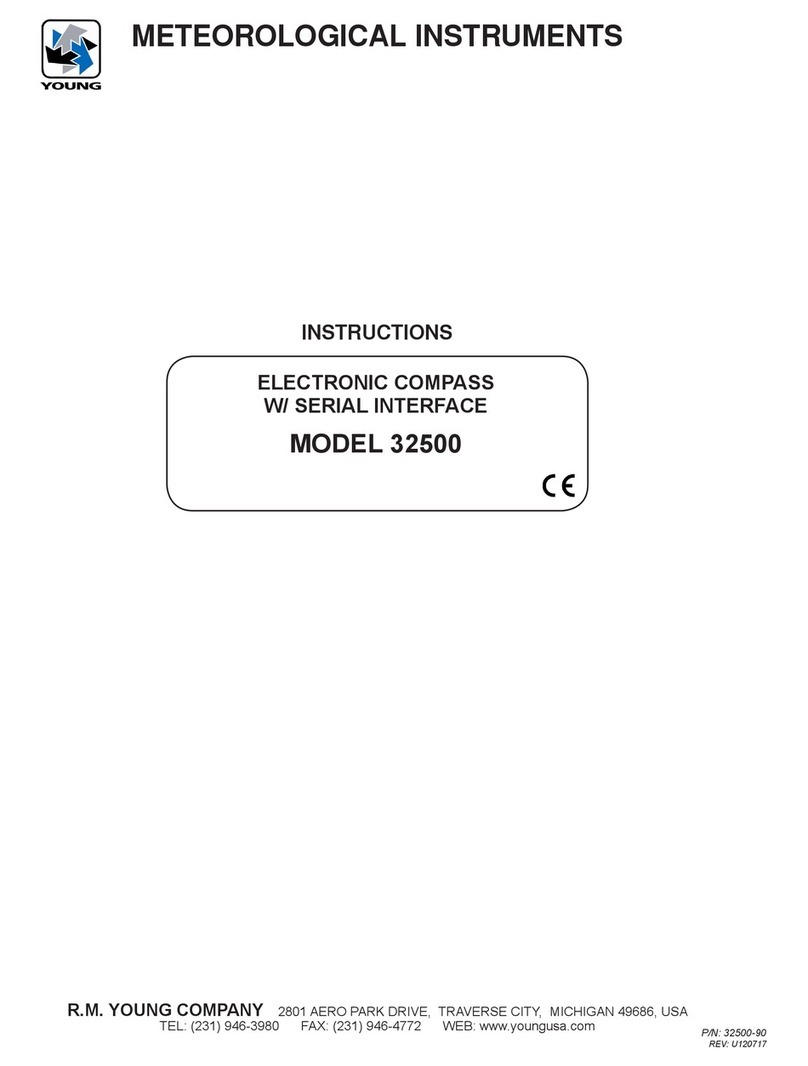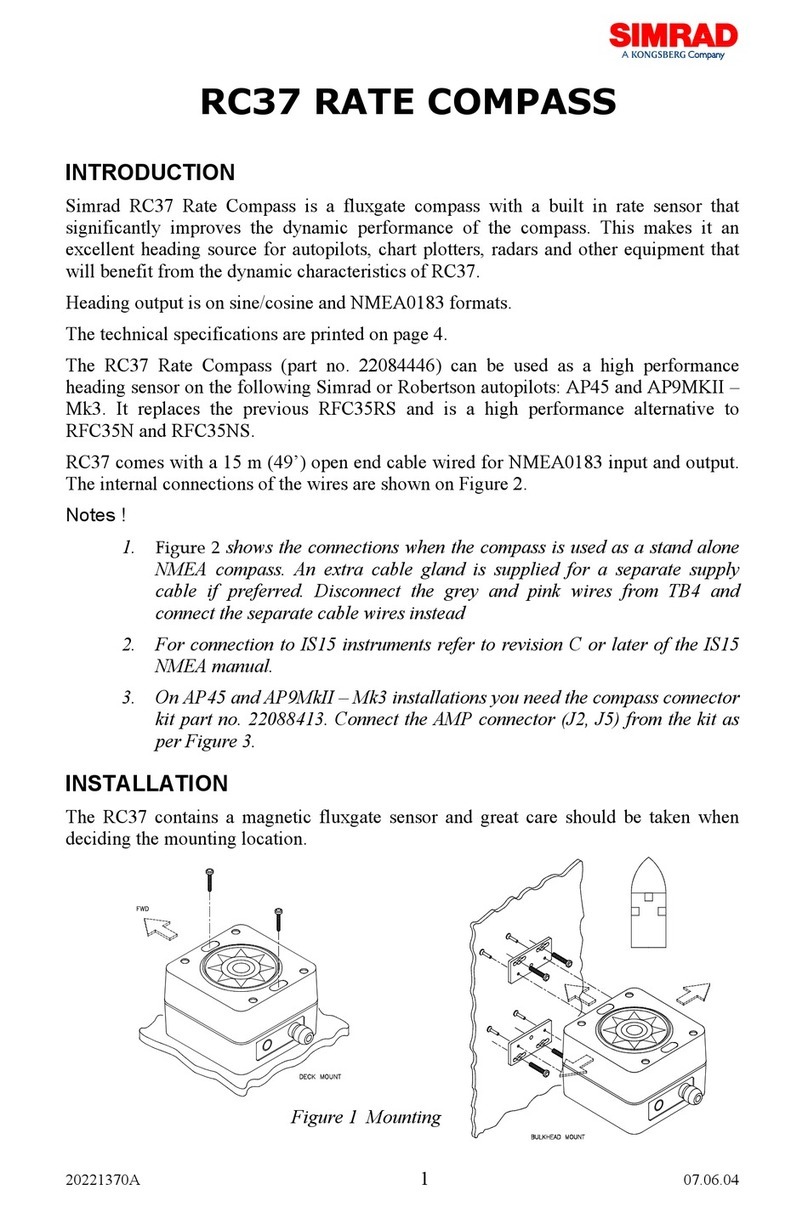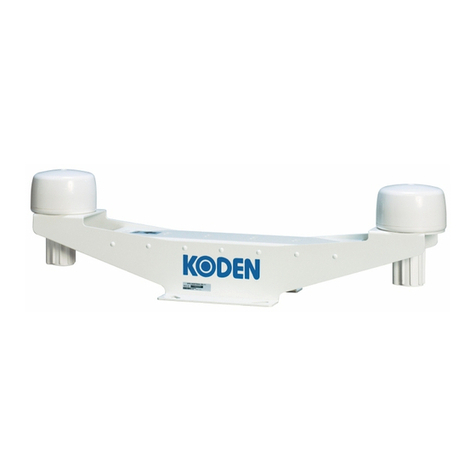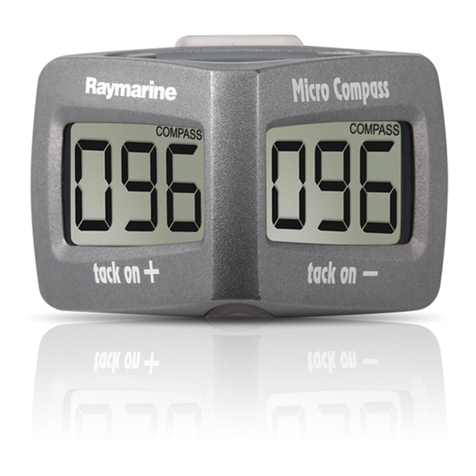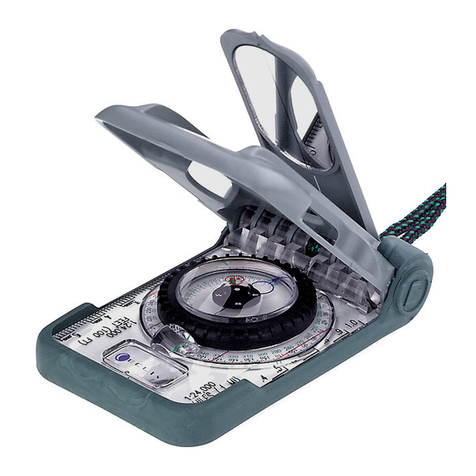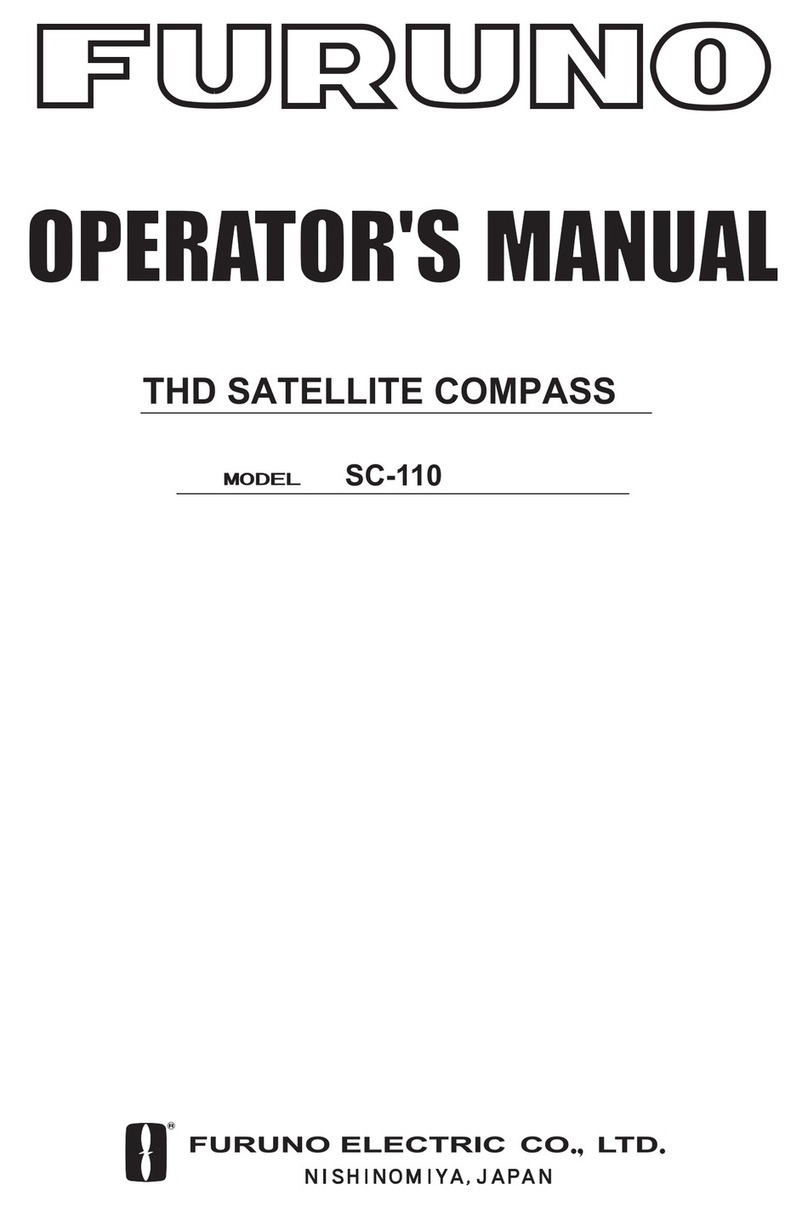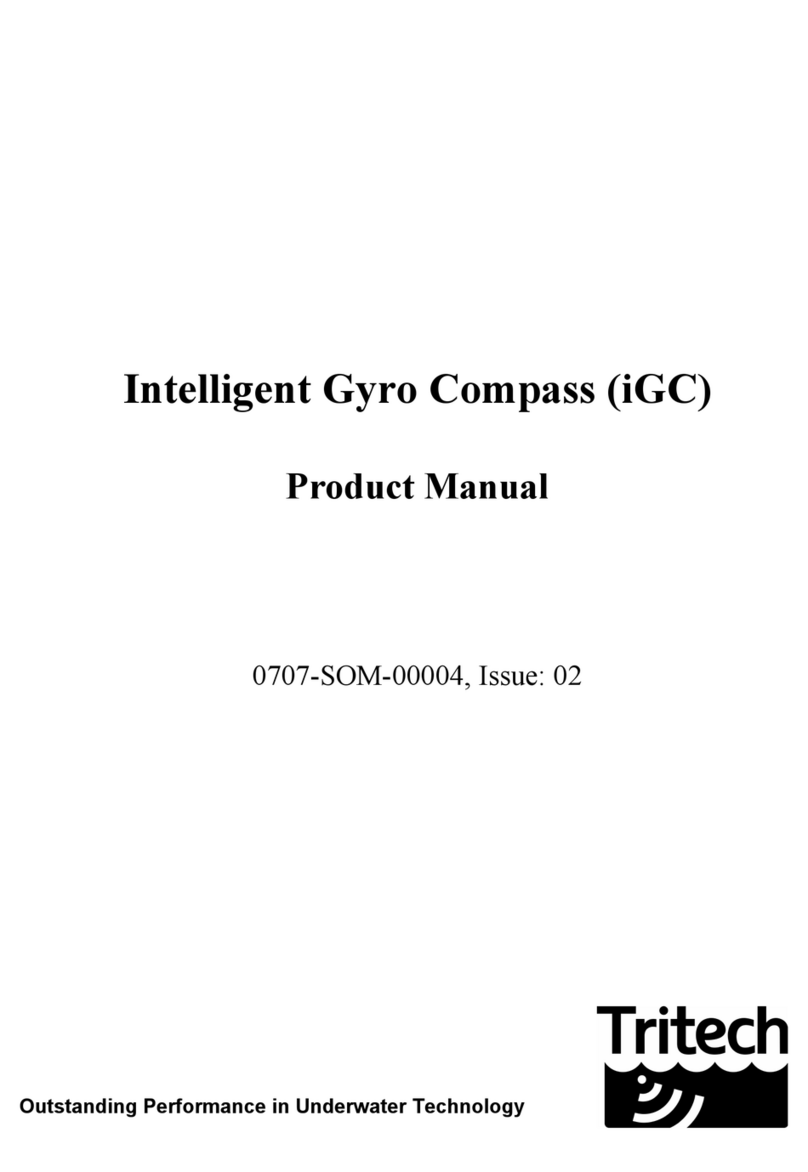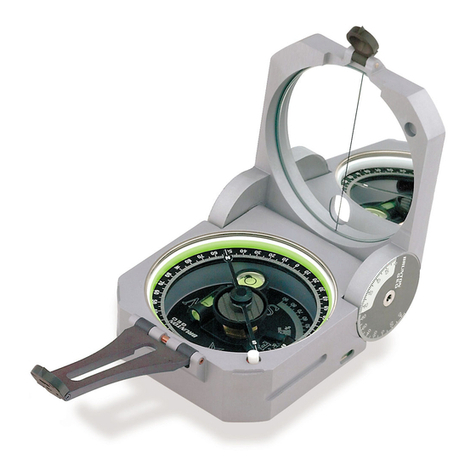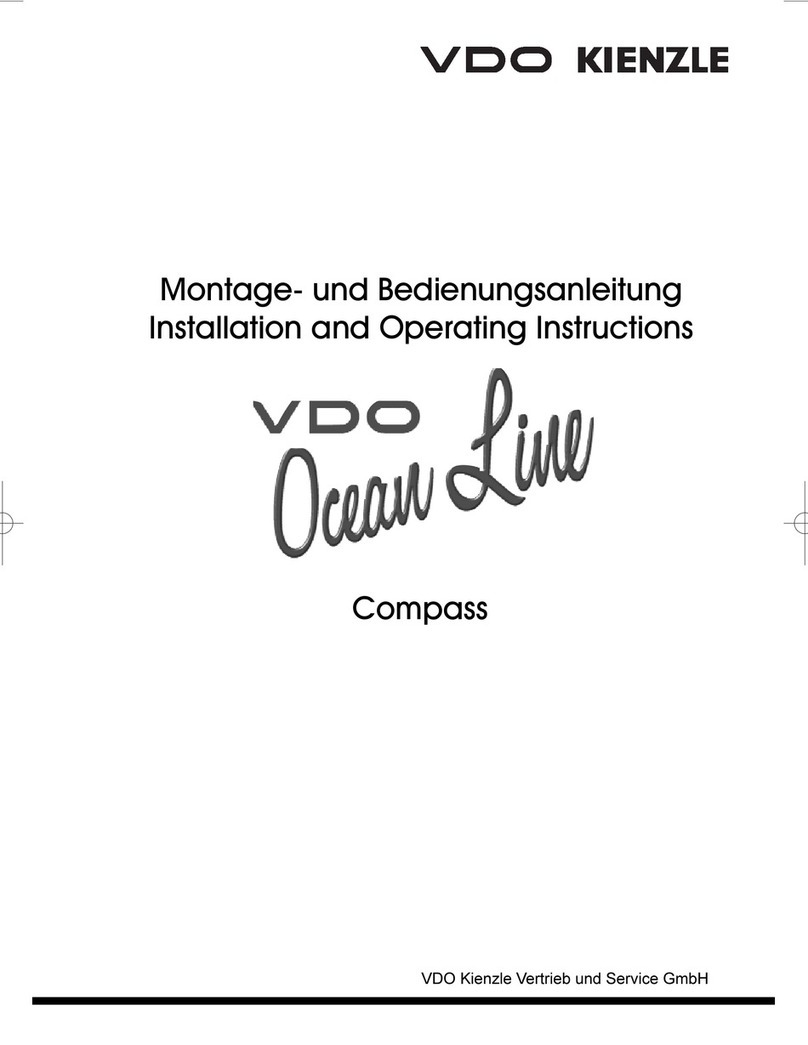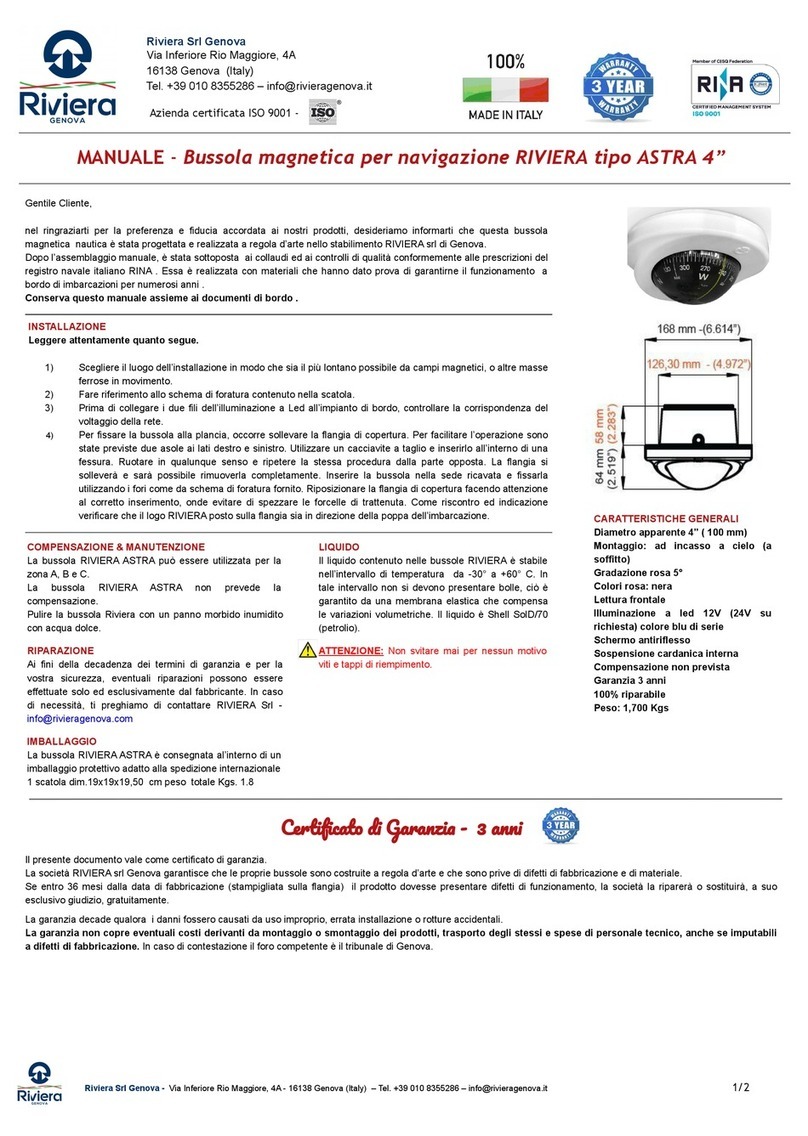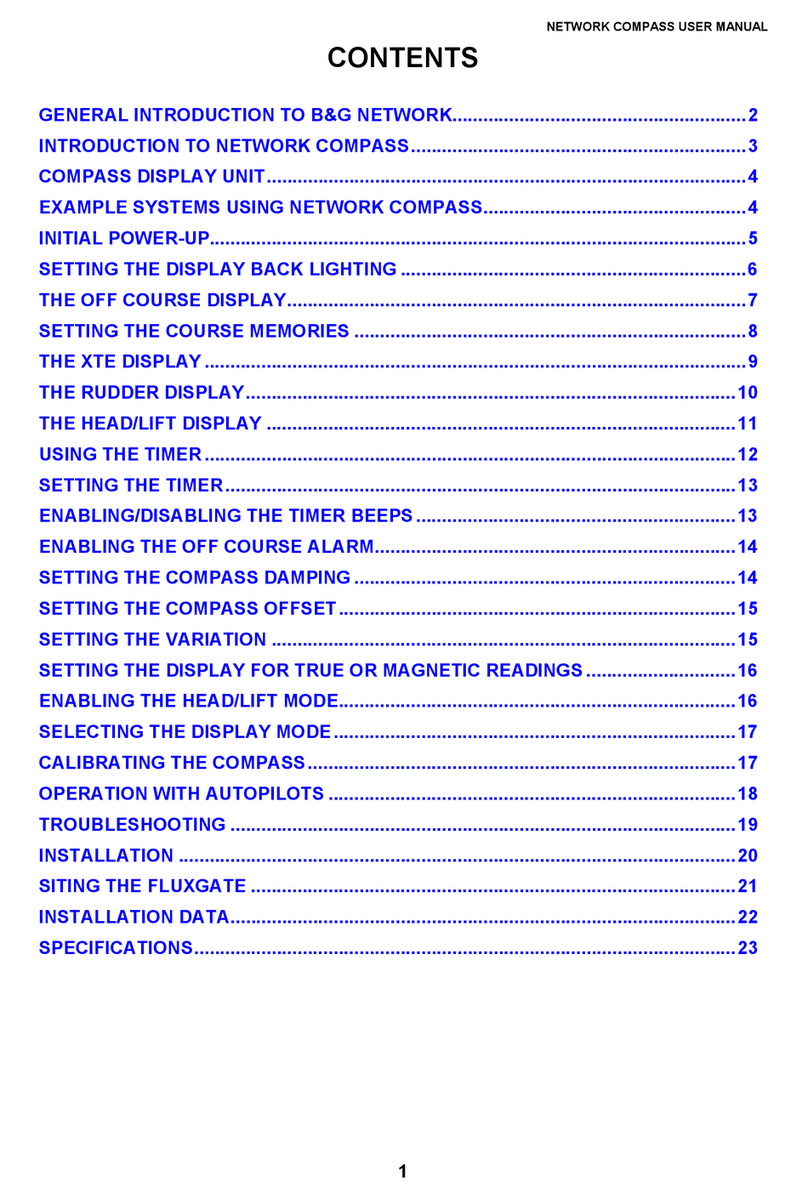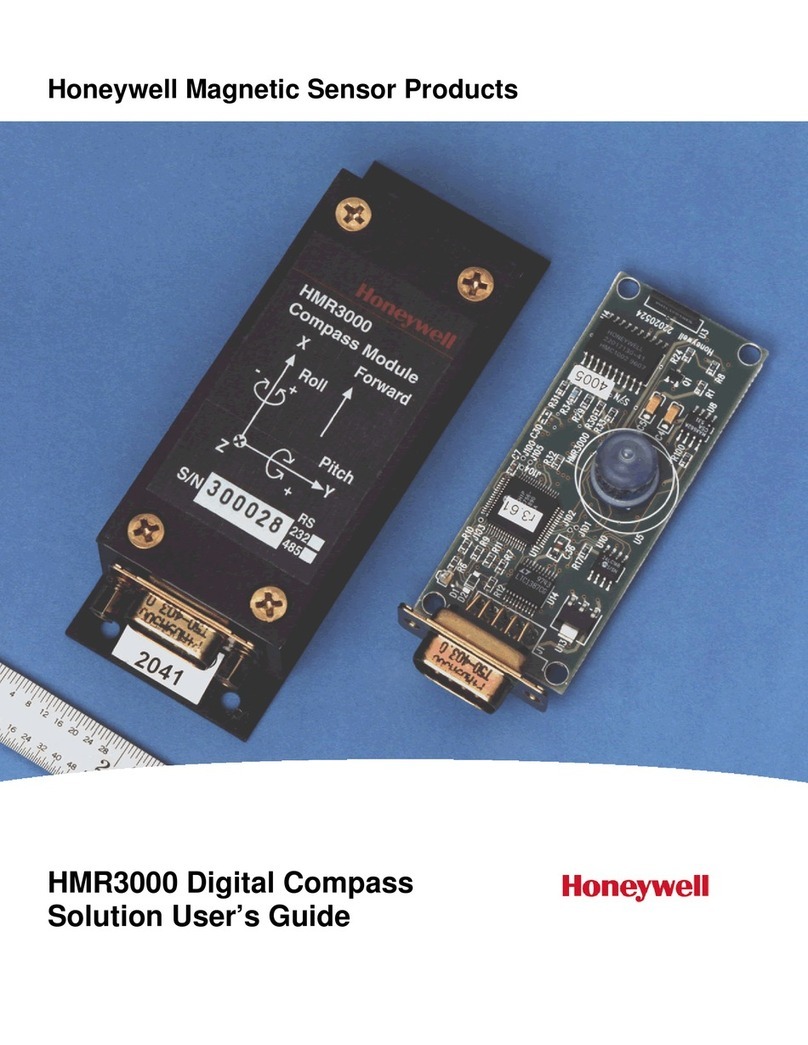R.M. Young 32500 User manual

METEOROLOGICAL INSTRUMENTS
INSTRUCTIONS
R.M. YOUNG COMPANY 2801 AERO PARK DRIVE, TRAVERSE CITY, MICHIGAN 49686, USA
TEL: (231) 946-3980 FAX: (231) 946-4772 WEB: www.youngusa.com
P/N: 32500-90
REV: S090915
ELECTRONIC COMPASS
W/ SERIAL INTERFACE
MODEL 32500

Page 1
32500-90(S)
MODEL 32500
ELECTRONIC COMPASS
WITH SERIAL INTERFACE
SPECIFICATIONS*
Compass:
Resolution: 0.5 degrees
Accuracy: ±2 degrees (rms)
Wind Speed Input:
Sensor Type: AC Frequency Generator
Sensitivity: 50mV p-p at 10Hz
Range: 0-2000 Hz
Wind Direction Input:
Sensor Type: Potentiometer
Range: 0-5000mV = 0 to 355 degrees
Excitation: 5000mV (limited to 5 mA)
Voltage Inputs (Auxiliary Sensor Inputs):
Resolution: 12-bit
VIN1 and VIN2 0-1000mV
VIN3 and VIN4 0-5000mV
Voltage Outputs:
OUT1 0-5000mV 0-100 m/s wind speed
OUT2 0-5000mV 0-360° true wind
direction
Serial Output: Full duplex RS-232,
Half duplex RS-485 (2 mS turnaround)
1200, 4800, 9600, 19.2K, & 38.4K baud
8 data, 1 stop, no parity
Operating Temp: -50°C to 50°C
Power: 11 to 30 VDC, 40 mA
Mounting: 1 inch IPS (1.34 inch actual diameter)
Size: 4.75” (12cm) H
0.87” (7.3cm) W
2.12” (5.3cm) D
*Specications subject to change
1.0 INTRODUCTION
The Model 32500 ELECTRONIC COMPASS measures magnetic head-
ing, wind speed and direction signals from YOUNG sensors, and signals
from four general purpose voltage inputs. Wind direction input may be
combined with compass measurements to obtain true direction. Voltage
inputs may be used with YOUNG temperature, humidity, barometric
pressure, and other sensors. One voltage input may be congured for
connection to a tipping bucket precipitation gauge.
Measurements are available in several serial data formats in either full
duplex RS-232 or half-duplex RS-485 signals. Both continuous and
polled serial outputs are available. When polled, up to 16 units can be
networked together. For marine applications the 32500 produces stan-
dard NMEA serial output sentences. Calibrated voltage outputs for wind
speed and direction are also provided when the 32500 is connected to a
YOUNG wind sensor.
2.0 INSTALLATION
The 32500 is supplied in a weather-resistant enclosure with a mount-
ing adapter that ts 1 inch IPS pipe (1.34 inch nominal diameter). When
used with the YOUNG Wind Monitor, the mounting adapter engages
the Wind Monitor orientation notch. Refer to the WIRING DIAGRAM for
electrical connection details and jumper settings.
It is important to install the 32500 so it remains level during operation.
This becomes increasingly important when used at northern and south-
ern latitudes far from the equator since progressively more of the earth’s
magnetic ux becomes vertical. By keeping the 32500 level at these
latitudes, the measurements will be free of the vertical ux inuence and
remain accurate.
If possible, avoid installing the compass near magnetic devices or ma-
chinery. After installation, the compass must be calibrated to correct for
local magnetic conditions. If the compass is moved or its local environ-
ment changes signicantly (machinery moved), the compass should be
calibrated again.
3.0 OPERATION
Operation begins automatically when power is applied. Jumpers cong-
ure the 32500 for common output formats.
3.1 COMPASS CALIBRATION
When the 32500 is operated for the rst time, its internal compass must
be calibrated for local conditions. To calibrate the compass, please follow
the steps outlined below.
1. Remove cover from compass. Press and hold CALIBRATE button
for 5 seconds. The CALIBRATE indicator will begin to blink. Refer to
WIRING DIAGRAM to locate CALIBRATE button.
2. Slowly rotate vehicle on which compass is mounted. Steer vehicle in
a tight circle and make TWO complete revolutions. Each revolution
should take at least one minute. THE COMPASS MUST REMAIN
LEVEL DURING CALIBRATION.
3. After two complete revolutions, press and hold CALIBRATE button
until indicator stops blinking. Calibration is now complete. Calibration
parameters are retained when power is removed.
4. Replace cover. Use this procedure to recalibrate compass at any time.
Serial communication command may also be sent to start and stop the
compass calibration. Please see section 4.2 SERIAL COMMANDS for
details.
3.2 SIGNAL INPUTS
The 32500 has two special wind speed and direction inputs for YOUNG
sensors and four voltage input channels for connection to other meteo-
rological instruments like temperature, humidity, and barometric pres-
sure sensors. Two of the voltage input channels may also be congured
as alternative wind speed and wind direction inputs for sensors like the
Young 86xxx family. For best performance, sensors should be installed
within 3m (10ft.) of the 32500.
Measurements from the voltage input channels are converted to nu-
merical values (0-4000) and sent in the serial ASCII output string:
VIN1 and VIN2 full scale input is 1000mV DC, therefore:
Input millivolts = Serial output value / 4
VIN3 and VIN4 full scale input is 5000mV, therefore:
Input millivolts = Serial output value x 1.25
VIN3 and VIN4 may be congured as alternative wind speed and direc-
tion inputs using CMD250 in SOFTWARE mode. Please see section 4.2
SERIAL COMMANDS.
Selecting PRECIP or PRECIP POLLED output formats will congure
VIN4 to count tips from a tipping bucket precipitation gauge.

Page 2
32500-90(S)
Please refer to SERIAL FORMAT DIAGRAM and WIRING DIAGRAM in
the Appendix for additional details.
3.3 JUMPERS
W1 JUMPERS A, B, and C, determine serial output format. Jumper
congurations and associated output format are listed below: 1 signies
that jumper is installed, 0 signies that jumper is omitted. See the
SERIAL FORMAT DIAGRAM in the Appendix for more details.
A B C SERIAL OUTPUT FORMAT (Baud Rate, Output Rate)
0 0 0 ASCII Ouput (9600, 2Hz)
0 0 1 Polled ASCII (9600)
0 1 0 NMEA1 (4800, 2 Hz)
0 1 1 NMEA2 (4800, 2 Hz)
1 0 0 RMYT (9600, 15 Hz)
1 0 1 PRECIP (9600, 15 Hz)
1 1 0 PRECIPT POLLED (9600)
1 1 1 SOFTWARE Mode (set by user, see section 4.2)
ASCII and POLLED ASCII are general purpose outputs that may be
used with the YOUNG 26800 or devices that can communicate serially.
NMEA outputs are generally for marine applications. RMYT is a propri-
etary format for use with the YOUNG Wind Tracker.
PRECIP and PRECIP POLLED formats congure VIN4 to count tips
from a tipping bucket precipitation gauge. (Requires a 10K ohm resistor
between EXC and VIN4.)
SOFTWARE mode allows output format and other parameters to be set
using serial commands. Please see section 4.0 SERIAL COMMUNICA-
TION and the SERIAL FORMAT DIAGRAM for more information.
W2 & W3 JUMPERS determine output connection type. Only one
connection type may be used at a time. Please refer to the WIRING
DIAGRAM in the Appendix for jumper location and connection details.
JUMPERS OUTPUT TYPE
VOUT Calibrated output for wind speed and direction.
OUT1 0-5000mV = 0-100 m/s Wind Speed
OUT2 0-5000mV = 0-360 degrees Wind Direction
232 RS-232 full duplex serial
485 RS-485 half duplex serial
4.0 SERIAL COMMUNICATION
The 32500 uses either full-duplex RS-232 or half-duplex RS-485 signals
for serial communication. RS-232 is the most simple and operates up
distances of 30m (100ft). The RS-485 option is preferred in electri-
cally noisy environments, in applications where multiple units must be
networked, or in NMEA marine applications where RS-485 signals are
required.
The full duplex RS-232 connection may transmit and receive serial data
at the same time.
The RS-485 connection is half-duplex meaning the unit cannot transmit
and receive at the same time. The 32500 internally manages the switch
between modes.
Many applications require the 32500 to transmit only. However, RS-485
applications that require polling the 32500 or sending commands to it
require that the externally connected serial device must be capable of
managing its own half-duplex switching from transmit to receive.
At low baud rates with proper cable installation and connections, trans-
mission distances up to 7km (4mi) are possible using RS-485.
Baud rates of 1200, 4800, 9600, 19.2K, and 38.4K baud are available.
Most jumper-selected output formats force the baud rate to a predeter-
mined value. All serial signals use 1 start, 8 data, and 1 stop bit. Any
externally connected serial device must be set to the same baud rate as
the 32500.
4.1 POLLING
When the serial output format is ASCII POLLED or PRECIP POLLED,
the 32500 sends data only when it receives a serial polling command:
Ma!
where ‘a’ is the unique address of the unit. The default address is ‘A’ but
any alphanumeric character may be used (see POLLING CHARACTER
in section 4.2 SERIAL COMMANDS).
See the SERIAL FORMAT DIAGRAM for details on ASCII POLLED
data format.
4.2 SERIAL COMMANDS
Serial commands set operating parameters and report settings.
Jumper W1 must be configured for SOFTWARE mode for serial
command settings to be retained, otherwise default settings
based on jumper configuration will take effect at next power up.
Commands may be sent using a PC and simple communications
programs such as HyperTerm or any other properly configured
serial device. All commands that begin with CMD must end with a
carriage return (ASCII 13).
Commands may be sent at any time but it may be more conve-
nient to pause 32500 serial output. This is especially necessary
with half-duplex RS-485 communication.
Command Description
CMD100 OPERATE
CMD110 PAUSE
CMD200 n DAMPING (0=NONE, 1=FAST, 2=SLOW)
CMD210 n FORMAT0 ASCII
1 ASCII POLLED
2 NMEA (KTS, DIR)
3 NMEA (KTS, DIR, TEMP, RH, BARO
4 RMYT
5 PRECIP
6 PRECIP POLLED
7 ASCII 2
9 DIAGNOSTIC
CMD220 n OUTPUT RATE (0=15Hz, 1=0.1Hz, 2=2Hz)
CMD230 c POLL CHARACTER (0-9, A-Z)
CMD240 nn BAUD RATE
(12=1200, 48=4800, 96=9600, 192=19200,
384=38400)
CMD250 n INPUT TYPE (1=PULSE/POT, 2=VIN3/VIN4)
CMD900 REPORT PARAMETER SETTINGS
CMD910 START COMPASS CALIBRATION
CMD920 STOP COMPASS CALIBRATION
X Alternative command to enter OPERATE mode
3xESC Alternative command to PAUSE
3xCNTL-S Alternative command to START compass cali-
bration
3xCNTL-X Alternative command to STOP compass cali-
bration
DAMPING determines the amount of averaging applied to the
compass measurement.
FORMAT determines serial output format. See Appendix for fur-
ther details. PRECIP formats substitute tipping bucket precipita-
tion counts for the VIN4 voltage measurement. ASCII 2 omits VIN
measurement values from the output string.
INPUT TYPE determines the type of wind speed and wind direc-
tion signal to use. Type 1 is for standard WS pulse input wind
speed and WD potentiometer wind direction input. Type 2 is for
VIN3 (wind speed) and VIN4 (wind direction). With Type 2 voltage
inputs, 0 to 5000mV = 0 to 100 m/s wind speed and 0 to 540 de-

Page 3
32500-90(S)
grees wind direction. These alternative inputs allow connection to
devices like the Young 86xxx family of 2D Sonic Anemometer.
OUTPUT RATE determines the rate at which serial data strings
are sent from the 32500.
POLL CHARACTER sets the unique polling address for the
32500. Any single alphanumeric character may be used.
BAUD RATE selects one of several preset baud rates. If you
change baud rate while connected, your external device must
also be changed in order to continue communicating with the
32500.
REPORT PARAMETER SETTINGS shows the current state of
Damping, Output Format, Output Rate, and Poll Character.
START and STOP COMPASS CALIBRATION commands perform
the same function as the CALIBRATE button. See section 3.1
COMPASS CALIBRATION for details regarding the calibration
procedure.
5.0 MAINTENANCE
The 32500 requires no maintenance in normal use. Periodic inspection
is recommended to verify correct operation.
6.0 WARRANTY
This product is warranted to be free of defects in materials and con-
struction for a period of 12 months from date of initial purchase. Liability
is limited to repair or replacement of defective item. A copy of the war-
ranty policy may be obtained from R. M. Young Company.

Page 4
32500-90(S)

Page 5
32500-90(S)

Page 6
32500-90(S)
APPENDIX B: WIRING CONNECTIONS

Page 7
32500-90(S)
APPENDIX B: WIRING CONNECTIONS

Page 8
32500-90(S)
APPENDIX B: WIRING CONNECTIONS
Other manuals for 32500
3
Table of contents
Other R.M. Young Compass manuals

